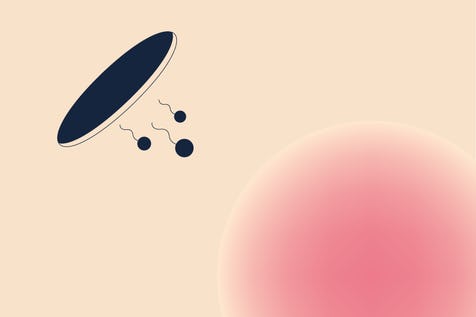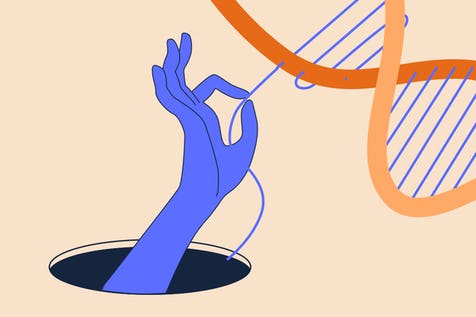Our skin is an ever-changing organ that responds to conditions such as climate, diet, and our menstrual cycle. The rise and fall of hormones released in our bodies have a direct impact on the way our skin behaves. This can result in a dewy facial glow leading up to ovulation, or the arrival of spots pre-menstruation; commonly known as hormonal acne. Such changes mean that, like tracking your mood or position of the cervix, it’s possible to monitor the appearance and texture of skin for signs related to the menstrual cycle.
We can often feel pressure to have clear, perfect skin all year round, with a misconception that facial spots and acne only affect teenagers. This could not be more wrong. Statistics show that over half of women will experience a rise in hormonal acne past the age of 25 years old (1, 2). The severity of these skin issues vary from person to person and act as a small reminder that menstrual-related hormonal breakouts are normal. In fact, the commonality provides us with rich knowledge about the behaviour of our hormones.
How do hormones impact my skin
Our skin is highly sensitive to the effects of hormones. The three main hormones released during our menstrual cycle are estrogen, progesterone, and testosterone (part of the family of androgens). These hormones impact the sebaceous glands. These glands cover our skin and respond predominantly to androgens such as testosterone. When levels of testosterone are higher, the size of the sebaceous glands increases and our skin produces a greater amount of an oily, waxy matter called sebum (3). This matter moisturises and protects our skin from infections. However, if sebum is overproduced or combines with dead skin cells, it can block the pores and provide an ideal place for bacteria to live. This can result in symptoms such as cystic hormonal acne and excessively oily skin.
Alongside the role testosterone plays on sebum production are the fluctuating estrogen and progesterone levels regulated by the menstrual cycle. Estrogen, released in larger quantities during the first half of the menstrual cycle, encourages skin thickness and hydration while stimulating the production of collagen. This can result in a fresher, plumper appearance, particularly around the days of ovulation when estrogen levels are at their highest. Post ovulation, the production of estrogen lowers and progesterone levels rise. The impact of progesterone on the skin is still under debate, but studies suggest that it can stimulate the production of sebum whilst also compressing the size of pores (3). These factors can encourage blockages within the pores and result in skin breakouts.
The release of testosterone stereotypically stays fairly low and steady throughout the menstrual cycle, with a little peak around ovulation (4). However, the days just before menstruation, when the levels of estrogen and progesterone dip, testosterone becomes the dominant hormone. This results in more sebum being produced and skin pores become smaller, meaning a higher chance of bacteria becoming trapped in the skin. Signs such as tender cysts and itchy skin can help you predict the start of menstruation. Studies show that up to 85% of women have greater signs of acne during this time, the rate of which is found to be significantly higher in women over the age of thirty (2). As menstruation begins, the production of all three hormones are at their lowest. This can result in the skin being drier, and looking dull. The sensitivity of the skin during menstruation can also be expected to increase due to the hormone prostaglandin. Though ever-present, when imbalanced, prostaglandin can make the skin more reactionary to pain (5).
Relationship between hormonal imbalances and skin issues
Due to the role hormones play in the health and condition of the skin, it can be expected that when hormone levels become imbalanced, this cycle of dull to dewy to pre-menstruation breakout acne will be disrupted. Being able to track any changes that occur alongside your menstrual cycle can offer an insight into your hormonal health and conditions that may need a closer look.
For women with polycystic ovarian syndrome (PCOS), an increased presence of testosterone can result in a higher chance of hormonal acne. Known to affect up to 10% of women, PCOS can be detected by a number of symptoms including breakouts around your cheeks, chin, jawline, and neck (6). Acne may present itself in tender cysts forming deep under the skin rather than fine surface bumps. PCOS can also cause weight gain and an excess of facial or body hair, so it’s good to monitor any changes that may be arising.
An important hormonal change in a woman’s life appears as she reaches menopause. Studies show that during the perimenopausal period (leading up to and 12 months after the onset of menopause), the drop in estrogen gives rise to androgen production which can result in acne flare-ups. As the body settles into a much lower production of estrogen, the skin is expected to adapt in a number of ways. Increased dryness, thinner skin, decreased elasticity, and increased wrinkles are common results of menopause (6). Due to the lower levels of estrogen, the skin will produce less collagen which may also result in itchy skin.
External factors impacting skin health
Despite the anticipated hormonal changes stimulated by the menstrual cycle, there are a number of external factors that can cause breakouts and impact the health of our skin. Diet, environment, and stress all play a significant role. Though it changes from person to person, caffeine, dairy, alcohol, and sugar can all be associated with an increase in skin issues (8). High glycemic index foods (such as sugary snacks and processed white bread) can increase insulin levels, stimulating the production of androgens, therefore, increasing the production of sebum and potentially causing breakouts on the skin (8, 9).
One observational study showed that daily stress exacerbated acne in a third of women; theorising that stress increases the production of androgens, giving rise to sebum production (2). Disruptions to mental health and sleep patterns can also imbalance the production of hormones and cause a delay in menstruation. This can have a knock-on effect on the way our skin will look, feel, and appear.
Genetics, seasonal changes, too much sun exposure, and excessive skincare routines can all impact the production of sebum. So when recognising any changes to your skin’s appearance, it’s important to note the multitude of factors within your life that may be playing a role.
Whether you are struggling with cystic hormonal acne, premenopausal breakouts, or continuous skin issues, know that you are not alone. Tracking signs of skin changes in sync with the menstrual cycle can help identify problems and ease your mind. It can be helpful to keep a food diary and let your skin exist in its natural state for a while to watch and note down any obvious signs or symptoms. As always, looking after yourself by eating, sleeping, exercising, and hydrating properly can work wonders for your skin and menstrual health.
References
1. Cordain L, Lindeberg S, Hurtado M, Hill K, Eaton SB, Brand-Miller J. Acne Vulgaris: A Disease of Western Civilization. Arch Dermatol. 2002;138(12):1584–1590. doi:10.1001/archderm.138.12.1584
2. Zeichner JA, Baldwin HE, Cook-Bolden FE, Eichenfield LF, Fallon-Friedlander S, Rodriguez DA. Emerging Issues in Adult Female Acne. J Clin Aesthet Dermatol. 2017;10(1):37-46.
3. Bakry OA, El Shazly RM, El Farargy SM, Kotb D. Role of hormones and blood lipids in the pathogenesis of acne vulgaris in non-obese, non-hirsute females. Indian Dermatol Online J. 2014;5(Suppl 1):S9-S16. doi:10.4103/2229-5178.144506
4. Reed BG, Carr BR. The Normal Menstrual Cycle and the Control of Ovulation. [Updated 2018 Aug 5]. In: Feingold KR, Anawalt B, Boyce A, et al., editors. Endotext [Internet]. South Dartmouth (MA): MDText.com, Inc.; 2000
5. Jensen DV, Andersen KB, Wagner G. Prostaglandins in the menstrual cycle of women. A review. Dan Med Bull. 1987 Jun;34(3):178-82. PMID: 3297513.
6. Sekhon AK, Zergham AS, Tserenpil G, Mebasher A, Malik BH. The Association Between Polycystic Ovary Syndrome and Its Dermatological Manifestations. Cureus. 2020;12(2):e6855. Published 2020 Feb 3. doi:10.7759/cureus.6855
7. Stevenson S, Thornton J. Effect of estrogens on skin aging and the potential role of SERMs. Clin Interv Aging. 2007;2(3):283-297. doi:10.2147/cia.s798
8. Kucharska A, Szmurło A, Sińska B. Significance of diet in treated and untreated acne vulgaris. Postepy Dermatol Alergol. 2016;33(2):81-86. doi:10.5114/ada.2016.59146
9. Pappas A. The relationship of diet and acne: A review. Dermatoendocrinol. 2009;1(5):262-267. doi:10.4161/derm.1.5.10192




